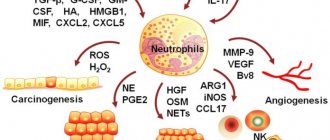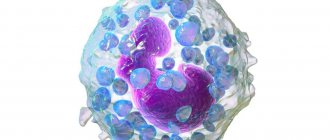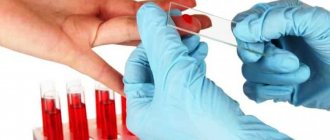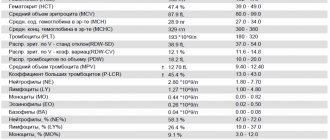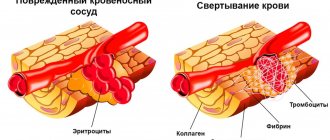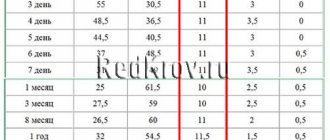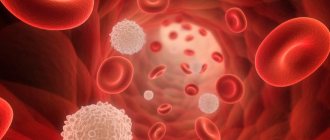To determine the state of the circulatory and immune systems, it is recommended to take a general blood test. It includes the leukocyte formula, which determines the state of all types of immunological cells. Depending on them, it is possible to identify the presence or absence of an inflammatory process and the area of its spread. Thanks to the timely detection of changes in the composition of the blood, it is possible to begin a comprehensive diagnosis, which allows identifying a temporary physiological deviation or severe pathology. The leukocyte formula may shift in a certain direction. If it is shifted to the left, you need to decipher the analysis from a doctor.
Possible deviations
As mentioned above, each leukocyte cell has its own characteristics and functions that make it unique.
Deviations from the norm to a greater or lesser extent make it possible to differentiate certain diseases, the manifestation of which is directly related to changes in indicators. Any deviations from the norm should be considered directly for each type of leukocyte.
Lymphocytes
Elevated levels (lymphocytosis) can occur as a result of the following diseases:
- viral and bacterial infections: influenza, whooping cough, rubella, measles, tuberculosis;
- bronchial asthma;
- congenital tendency to allergies (allergic dermatitis);
- autoimmune diseases: Crohn's disease, Lyme disease.
Also, an increase in the number of lymphocytes can occur in absolutely healthy children in the first year of life if their diet is dominated by carbohydrate foods.
The interpretation of the analysis, in which a lack of lymphocytes is noted, indicates pathologies and diseases of the bone marrow, which is unable to fully synthesize lymphocyte cells in the required volume.
It can develop in three directions:
- disruptions in the process of lymphopoiesis;
- low life expectancy of lymphocytes;
- hormonal disruptions of lymphoid tissue.
Eosinophils
A significant excess in the number of eosinophils indicates two possible pathologies:
- an allergic reaction in a child to dairy products, lactose and gluten;
- helminthic infestations that remain untreated for a long time.
Eosinophilia has no external signs, but can have a rapid course, after which irreversible processes begin.
Monocytes
Monocytosis can be the cause of fungal and viral diseases. It usually has external clinical manifestations:
- lymphadenopathy;
- inflammatory processes of the nasopharynx and larynx with neoplasms;
- enlargement of the liver, accompanied by pain in the right hypochondrium.
The reverse phenomenon of monocytopenia develops against the background of a lack of B vitamins, folic acid in the body and the development of iron deficiency anemia.
Neutrophils
Neutrophilia, in which there is a significant increase in the number of neutrophils in the blood, can occur as a natural protective reaction.
What is typical for extensive inflammation and systemic lupus. Neutropenia, which is characterized by a decrease in the level of neutrophils in the blood, occurs as a result of hormonal imbalances or in the presence of suppressed neutropoiesis in the bone marrow.
The reasons for what is happening may be extensive intoxication, in which newly formed cells are not able to fully function in the body.
Basophils
These cells are responsible for the increase in the allergic reaction. Basophilia itself is a rather rare phenomenon, which develops only in isolated cases in the presence of dangerous pathologies: tuberculosis of the lymph nodes, myeloid leukemia, blood cancer.
With basophilia, the leukogram shifts to the right, and the leukocyte formula changes its parameters in proportion to the basophils.
Indications for analysis
Collection of biomaterial for subsequent assessment of the leukogram is advisable in one of the following cases:
- Passing a medical examination.
- Pregnancy planning.
- Preparing for surgery.
- Diagnosis of any pathology (leukocyte formula refers to one of the main types of walking OAC).
- Exacerbation of chronic pathology.
- Acute abdominal pain, increased sweating at night, weight loss, shortness of breath, diarrhea, enlarged lymph nodes.
Clinical indications for prescribing OAC with leukogram:
- Hyperthermia.
- Feverish condition.
- Pain in the joints.
- Body aches, general malaise.
- Headache.
- The need for differential diagnosis between viral and bacterial infections.
- Enlarged lymph nodes.
- Increased bleeding.
- Pustular rash on the body.
- Taking immunosuppressive drugs.
- Carrying out chemotherapy or radiation therapy.
- Night sweats.
- Routine examination during hospitalization.
- Routine examination of pregnant women.
Leukocyte formula of adults in
| Kinds | Content % | Absolute value (number of cells X 10?/l) |
| Lymphocytes | 19-37 | 1,2-3 |
| Monocytes | 3-11 | 0,09-0,6 |
| Band neutrophils (immature) | 1-6 | 0,04-0,3 |
| Segmented neutrophils | 47-72 | 2-5,5 |
| Basophils | 0-1 | 0-0,065 |
| Eosinophils | 0,5-5 | 0,02-0,3 |
In medical practice, usually when the leukocyte formula increases or decreases, add an ending, for example, when monocytes in the blood increase, add “oz” - monocytosis or “ia” - eosinophilia.
When the “singing” indicator decreases, leukopenia, lymphopenia, etc.
At the same time, the formula is also distinguished into absolute and relative changes. In the first case, there is a deviation from the norm in the percentage of white blood cells.
In the second, about deviation both in % and absolute terms. This refers to the change in the total number of cells per unit volume of blood.
The leukocyte formula is not constant and changes depending on the patient’s age, as well as taking medications or illness.
Children have a different leukocyte formula.
Complete blood count of the child: eosinophils
Similar to neutrophils, eosinophil cells contain certain enzymes or granules within themselves. Eosinophils are neutralized not by bacteria, but by immune complexes. When taking a general blood test from a healthy child, their number is most often relatively small (about 1-4%, no more). But their numbers increase significantly, which is called eosinophilia , with various allergies, intestinal diseases, even skin diseases, etc.
Very often, eosinophelia occurs after severe, especially bacterial infections.
Features of the leukocyte formula in children
Oddly enough, the leukocyte formula has nothing to do with the mathematical formula.
This analysis displays the percentage of certain types of leukocytes contained in the total leukocyte mass. If a general blood test shows only an average value, then this study helps to see which cells are produced and in what quantity, so that these indicators can then be compared with generally accepted norms. Leukocytes are the body’s natural defense against viruses and bacteria that enter the body from the outside. The bone marrow is capable of synthesizing white blood cells, which, if necessary, are activated and inhibit the development of pathogenic microflora. A reserve supply of cells is contained in the liver and spleen, but the cells themselves do not live long and are constantly renewed.
All leukocytes are divided into two large groups:
- Granulocytes have a clearly defined nucleus and peripheral muscles, thanks to which they are able to actively move and move in the blood stream not only under pressure, but also spontaneously.
- Agranulocytes lack a nucleus and remain relatively motionless, but actively fight foreign microorganisms by producing antigen.
Based on their qualitative content, leukocytes are usually divided into 5 types:
- lymphocytes;
- monocytes;
- eosinophils;
- basophils;
- neutrophils.
Each cell in the body has its own role, so their active production may indicate the presence of a specific disease in children.
The leukocyte formula shows what percentage of cells of one type or another are contained in every 100 leukocytes. This relative ratio allows you to identify all the cells present in the smear, as well as estimate their number in the total leukocyte mass.
In what cases is it done?
Analysis for leukocytes in children is carried out as planned, adhering to the following scheme:
- up to a year - every trimester;
- 1-3 years – once (once a year);
- 3-6 years – according to doctors’ indications;
- 6-12 years - as planned when undergoing an annual medical examination;
- 12-18 years old - planned and unplanned, in the presence of chronic diseases.
Indications for studying the leukocyte formula may include such manifestations as:
- poor sleep;
- excessive sweating;
- poor appetite;
- frequent rhinitis;
- constant acute respiratory infections and acute respiratory viral infections;
- enlarged lymph nodes.
Typically, the leukocyte count is assessed during hospitalization of a sick child to confirm or refute the diagnosis made by the doctor.
Main types of leukocytes and their functions
Leukocytes are immune cells; they perform a number of functions aimed at protecting the body from foreign agents and microorganisms. Depending on the presence of granules in the cytoplasm of leukocytes, they are divided into 2 types:
- Granulocytes - contain granules in the cytoplasm with various biological compounds, these include basophils, neutrophils, eosinophils.
- Agranulocytes - accordingly, do not contain granules in the cytoplasm; such cells include lymphocytes and monocytes.
Each type of these immune cells performs its main functions in the human body:
- Segmented neutrophils - protect the body from various foreign agents, primarily from pathogenic (disease-causing) bacteria and fungi. The defense mechanism is phagocytosis - the process of absorption and digestion of a foreign agent by a neutrophil. Young forms of these cells also circulate in the blood - rod and juvenile forms.
- Eosinophils - contain a large number of granules in the cytoplasm, which are filled with biologically active compounds. These cells are directly involved in the allergic reaction (hypersensitization reaction), which develops in response to allergens entering the body. At the same time, eosinophils release the contents of granules (histamine) into the blood, which leads to the development of allergy symptoms.
- Basophils - these cells also contain various mediators of the allergic reaction; they are more localized in the tissues of the area of the highest concentration of the allergen. When the contents of their granules are released, a local allergic reaction (redness, rash, itching) develops.
- Lymphocytes - these cells perform a large number of functions - the synthesis of antibodies (B-lymphocytes and plasma cells), the direct destruction of altered cells of their own tissues under the influence of viruses or a tumor process (killer T-lymphocytes). There are also helper T-lymphocytes, which regulate the functional activity of other immune cells, and memory B-lymphocytes (contain on their surface receptors for a foreign agent with which the human body has had contact at least once; when such an agent enters again, these cells begin to rapidly multiply and synthesize specific protective antibodies).
- Monocytes - they perform the function of phagocytosis; from the blood they rush into the tissues of the area of the inflammatory process, where they identify, absorb and digest foreign agents (fungi, bacteria, viruses).
Pus, which is formed as a result of various inflammatory processes, represents dead neutrophils and microorganisms.
Normal indicators
Leukoformula analysis represents the proportion of all types of leukocytes. Most often, the examination is attributed in parallel to the general analysis.
Now let's look at the main indicators and components that are closely monitored during the test:
- Neutrophils are primarily used to provide adequate levels of protection. They can determine which bacteria are harmful, then influence them until they are destroyed.
- Basophils are components that appear during all kinds of allergic reactions. These components have the effect of neutralizing poisons and toxins, preventing the spread of harmful substances through the blood supply system.
- Eosinophils in the blood help destroy various parasitic bacteria. It is thanks to them that antiparasitic resistance is observed in the body.
- Monocytes are very similar in functionality to neutrophils. The main difference is the higher phagocytic effect. They also allow you to kill parasitic bacteria, while the leukocytes that die during exposure are absorbed, which leads to blood purification;
- Lymphocytes are substances that have a kind of memory; they recognize antigens and remember them. The component provides immunity to viruses and tumors.
Norms of various types of leukocytes in the leukocyte formula
For a healthy person, depending on age, there are special standards that indicate the state of the body based on the leukocyte formula.
| Age | Leukocyte ratio (cells/µl) |
| Up to 1 year | 6 – 17,5 |
| 1-2 years | 6 – 17 |
| From 2 to 4 years | 5,5 – 15,5 |
| From 4 to 6 years | 5 – 14,5 |
| From 6 to 10 years | 4,5 – 13,5 |
| From 10 to 16 years | 4,5 — 13 |
| Over 16 years | 4,5 — 11 |
Leukocyte formula of a healthy person
The leukoformula represents the total proportion of all leukocytes. There is more accurate information - leukocyte indices. This examination allows you to determine the number of different types of components of the group of leukocytes. The intoxication index is considered an extremely useful indicator; based on the test readings, the degree and severity of inflammation can be determined. It is also possible to determine the level of an allergic reaction, based on allergization, and the effectiveness of the system, due to immunoreactivity, etc.
Explanation and description
The composition of the blood can change throughout life, so the leukocyte formula is assessed taking into account age-related changes.
At birth in children, most of the leukocytes are neutrophils (about 65-70% of the total mass). Lymphocytes account for only 25-30%. This indicates that all organs and systems are activated in the newborn’s body, which will henceforth function as a separate organism that does not receive nutrition from the mother’s body. In the first days of life, hormonal changes occur, as a result of which the first leukocyte crossover is observed, in which the percentage of lymphocytes and neutrophils equalizes. By the first month of life, children's bodies produce more lymphocytes than neutrophils, forming reliable protection for the body. In the total mass, lymphocytes occupy 65%, leaving only 15-20% for neutrophils. This provides the child of the first year of life with reliable immunity, which he needs in understanding the world.
After a year, when children’s immunity is definitely formed, there is a gradual decrease in the lymphocyte mass in favor of neutrophils, which is also controlled by biological processes and is necessary for the development of all types of immunity. By the age of four, a second crossover is observed, in which lymphocytes again align with neutrophils, forming a powerful barrier to microbes and pathogens. After this, the number of lymphocytes gradually increases, and the remaining leukocyte cells are produced as needed.
By the age of 6, the composition of a child’s blood is close to the blood of an adult, where the majority of the total mass is occupied by neutrophils and lymphocytes.
During the period of hormonal changes, the leukocyte formula may have slight deviations from the norm by 10-15%, which is not pathological and directly depends on the biological processes in the body.
Leukogram at birth and in the first month of life
When born, the child’s body begins to adapt to environmental conditions, which is reflected in physiological processes. From here, the following normal indicators are identified for the first week of life, the decoding of which is included in the table.
| Name of leukocytes | Normal value in % of total leukocyte mass |
| neutrophils | 65 |
| lymphocytes | 20-35 |
| monocytes | 3-5 |
| basophils | 0-1 |
| eosinophils | 1-2 |
By the first month of life, the picture changes somewhat, allowing the body to receive reliable protection from lymphocytes.
| Name of leukocytes | Normal value in % of total leukocyte mass |
| lymphocytes | 65-70 |
| neutrophils | 20-25 |
| monocytes | 3-6 |
| basophils | 1-2 |
| eosinophils | 0,5-1 |
Leukocyte formula from 1 to 3 years
During this period, the number of lymphocytes and neutrophils is unstable and can change not only during the day, but also under certain conditions: prolonged exposure to the sun, hypothermia, chronic or genetic diseases.
| Name of leukocytes | Normal value in % of total leukocyte mass |
| neutrophils | 32-52 |
| lymphocytes | 35-55 |
| monocytes | 10-12 |
| basophils | 0-1 |
| eosinophils | 1-4 |
Indicators from 4 to 6 years
Neutrophils again take precedence over lymphocytes, so the decoding with normal indicators will look like this.
| Name of leukocytes | Normal value in % of total leukocyte mass |
| neutrophils | 36-52 |
| lymphocytes | 33-50 |
| monocytes | 10-12 |
| basophils | 0-1 |
| eosinophils | 1-4 |
Leukocyte formula norms after 6-7 years
After 6 years, the leukocyte composition norm is identical to that of an adult.
| Name of leukocytes | Normal value in % of total leukocyte mass |
| lymphocytes | 19-35 |
| neutrophils | 50-72 |
| monocytes | 3-11 |
| eosinophils | 1-5 |
| basophils | 0-1 |
During the period of hormonal changes, a shift of the leukogram by 10-15% is allowed.
Complete blood count of the child: lymphocytes
Similar to neutrophils, lymphocytes can differ significantly from each other. But it is impossible to establish it using a microscope. They have no fundamental external differences. However, lymphocytes take a very active part in various immune-type reactions: they ensure the synthesis of bodies, the normal functioning of all immune systems (general and local), etc.
The need of the child's body for the mentioned immune-type reactions is very, very high. For this reason, lymphocyte is the main, most common leukocyte in a child’s general blood test. At the age of approximately one month to 2 years, the level of lymphocytes in a child can reach its maximum value. After 2 years it begins to fall (slowly), and by 4-5 years the number of lymphocytes becomes approximately equal to the number of neutrophils.
Important ! Be sure to keep in mind that even at the age of 15, a child will have a higher level of lymphocytes than an adult.
An increase in the number of lymphocytes or lymphocytosis can be observed in a variety of childhood diseases caused by various infections, especially viral ones. When any viral infection enters a child’s body, an increase in the number of lymphocytes can be observed for a long time - up to 3 weeks, and sometimes up to 2 months.
What is leukocyte formula
Blood cells known as white cells or leukocytes play an important role in the body's immune system - they identify and neutralize foreign agents, viruses and bacteria. There are five types of leukocytes in total, each of which performs its own function.
- Lymphocytes destroy foreign agents, malignant cells, and are also responsible for the production of protective antibodies.
- Eosinophils are directly involved in the formation of the immune system's response after irritants enter the body, and are responsible for antiparasitic defense.
- Monocytes are necessary for the normal process of absorption of foreign bodies, the formation of an immune response and tissue repair.
- Neutrophils secrete substances that have a bactericidal effect and are responsible for the absorption of harmful microorganisms. They are divided into segmented and band (immature) cells.
- Basophils ensure the movement of other types of white cells to the site of infection and take part in the formation of allergic reactions.
The number of white cells can vary depending on age and some physiological factors, therefore, when determining the number of leukocytes, the characteristics of the patient’s body are taken into account. Norms for the number and percentage of leukocytes for adults
| Type of leukocytes | Number of cells in the sample x 109/l | Percentage |
| Lymphocytes | 1,2-3 | 19-37 |
| Segmented neutrophils | 2-5,5 | 47-72 |
| Band neutrophils | 0,04-0,3 | 1-6 |
| Monocytes | 0,09-0,6 | 3-11 |
| Eosinophils | 0,02-0,3 | 0,5-5 |
| Basophils | 0-0,065 | 0-1 |
Leukocyte formula
Since human blood mainly consists of lymphocytes and neutrophils, abnormalities are most often associated with these types of leukocytes. The norms of band and segmented neutrophils in representatives of both sexes are approximately the same, and changes in the leukoformula depend on age.
| Age | Norms of band neutrophils | Norms of segmented neutrophils |
| Newborns | 5-12 | 50-70 |
| 1 Week | 1-5 | 35-55 |
| 2 weeks | 1-4 | 27-47 |
| 1 month | 1-5 | 17-30 |
| 1 year | 1-5 | 45-65 |
| 4-5 years | 1-4 | 35-55 |
| From 6 years | 1-4 | 40-60 |
Analysis technique
Calculations of the leukocyte formula are carried out by qualified health workers using the method of studying smears under a microscope.
In addition, a hematology automatic analyzer is often used. If certain deviations are detected, an additional microscopic assessment of the smear is carried out, with a description of the clear morphology of visible cells and clarification of the leukogram.
Automatic devices make it possible to obtain better results: with technology, it is possible to examine more than 2000 cells, and under a microscope only 200. During a blood test on an analyzer, the result will be more informative.
Automatic counting also has a number of disadvantages, because it is not able to distinguish neutrophils into segmented and band types.
Functional characteristics of leukocytes
The functions of white blood cells, as well as their number in the bloodstream, vary depending on the tasks that particular white blood cells perform.
Neutrophils, which are the most numerous, are the first to fight the body against infections or when a foreign body penetrates.
In this case, phagocytosis of harmful microorganisms occurs, that is, their absorption by neutrophils. The structure of neutrophils differs from other leukocytes.
Video:
Depending on the degree of ripening, they are divided as follows:
- polymorphonuclear, or mature, neutrophils. They have several nuclei, so their second name is segmented;
- germinal or young cells. Because they have one nucleus, scientists consider them to be band neutrophils.
When interacting with harmful cells, neutrophils inject bactericidal substances into the blood.
Lymphocytes are considered one of the most important components of the body's immune defense. T lymphocytes destroy damaged cells and prevent the spread of infection.
B-lymphocytes are responsible for the synthesis of antibodies - specific cells of protein structure that interact with proteins of pathogenic microorganisms, after which they become available to neutrophils and monocytes that eat pests.
Human bone marrow tissue does not produce very many monocytes, but their functionality is great.
After a relatively short stay in the human bloodstream, they pass into tissues, where they turn into macrophages, which are capable of both phagocytosis and reaction with proteins of harmful microorganisms.
Eosinophils, like monocytes, are few in human blood, and they are capable of phagocytosis.
However, their main task is to destroy parasites and reactions with histamine, which makes possible an allergic response of the immune system to certain foci of inflammation.
Basophils mainly perform transport work, being responsible for the delivery of other leukocytes to the inflammatory focus.
In tissues, they function as so-called “mast cells,” participating in the synthesis of connective fibers and producing histamine, a large amount of which in the bloodstream causes skin allergies.
Complete blood count of the child: plasma cells
The purpose of plasma cells in the formation of antibodies. For adults, the norm is their complete absence in the blood, but in a child, only one in 200–400 leukocytes can be found.
An increase in their number symbolizes the presence of a viral infection, but one that has a detrimental effect (destroys) lymphoid tissue: rubella, measles, chicken pox, infectious mononucleosis.
You can read about the reliability of materials related to child health by clicking on the link provided.
You can find more information on your child’s health in the section of our parents’ club of the same name by following the link provided, and/or in its subsection “Handbook for Parents.”
Reasons for increased leukogram
Various infectious diseases and other pathological conditions cause an increase in the leukocyte count of the blood. By studying these numbers, the doctor can, together with the clinical manifestations, pinpoint the cause of this increase.
Lymphacytosis develops in various pathological conditions in the body:
- infection with mononucleosis, chickenpox, rubella, measles;
- chronic pathologies caused by pathogens of brucellosis, tuberculosis, syphilis;
- hyperthyroidism;
- development of lymphosarcoma, lymphocytic leukemia;
- plastic and hypoplastic anemia, folate deficiency;
- insufficient function of the adrenal cortex.
Neutrophilia will be present during the processes:
- acute blood loss;
- acute bacterial pathologies;
- tissue necrosis;
- acute intoxication;
- taking hormonal steroid drugs.
A high composition of eosinophils occurs:
- With scarlet fever.
- Infection with helminthiases.
- Infections in the recovery stage.
- For allergic reactions.
- Chronic skin diseases: eczema and psoriasis.
- With eosinophilic leukocytosis.
Elevated numbers of monocytes indicate the presence of:
- hemoblastoses;
- infectious diseases;
- autoimmune diseases;
Basophils increase:
- With erythremia.
- If chronic myeloid leukemia occurs.
- For allergic reactions.
Deviations from the noma in adults
Lymphocytosis, manifested by an increase in the concentration of lymphocytes in the bloodstream, can indicate the development of one of the following pathologies:
- Chicken pox.
- Syphilis.
- Rubella.
- Leukemia.
- Lymphoma.
- Tuberculosis.
- Measles.
Low lymphocyte counts may occur due to:
- Immunosuppressive conditions.
- Autoimmune diseases.
- Kidney dysfunction.
- Deficiency of nutrients and microelements.
- Radiation therapy.
- Treatment with corticosteroids.
An increase in the number of neutrophils is an important indicator of the following diseases:
- Acute hemorrhage.
- Intoxication.
- Development of diseases of bacterial etiology.
- Myocardial infarction.
- Vasculitis.
- Malignant neoplasms.
- Autoimmune pathologies.
If the analysis shows a low concentration of neutrophils, doctors may suspect the following pathologies:
- Immunosuppressive conditions.
- Effect of ionizing radiation.
- Progressive infectious disease.
An increase in monocytes indicates the following conditions:
- Infections that occur due to the influence of bacteria.
- Progression of rheumatoid arthritis.
- Infectious mononucleosis.
- Parasitic infestations.
- Hemoblastoses.
A low concentration of monocytes in the lymphocyte formula helps to suspect pulmonary tuberculosis. If a high level of basophils is detected, one may think about the presence of chronic myeloid leukemia or erythremia. Deciphering the leukocyte formula in adults may show an increase in eosinophils, which is often detected during:
- Allergies.
- Scarlet fever.
- Parasite infestations.
- Skin pathologies.
- Eosinophilic leukemia.
A decrease in eosinophils in an adult can be triggered by progressive typhoid fever or adrenal hyperactivity. Deciphering the leukogram is performed with an assessment of nuclear shifts, where special attention is paid to the ratio of mature and immature neutrophils.
At the moment, the leukocyte formula is considered one of the most important indicators in diagnosis. Carrying out a CBC with an assessment of the leukogram makes it possible to discuss the presence of acute pathological conditions, the effectiveness of the prescribed therapeutic course, as well as possible prognoses for the future.
Shift in leukocyte formula, what deviations indicate
When carrying out laboratory analysis, the final stage is the construction of a leukogram. This spectral indicator is presented in graphical form and shows in which direction the leukocyte formula shifts, taking into account the quantitative and qualitative composition of the blood.
Shift left
The reason for the shift of the leukogram to the left may be such manifestations as:
- a significant increase in band neutrophils;
- the predominance of young forms of leukocytes over old ones.
All this indicates the following health problems in the child:
- the presence of foci of inflammation in the acute stage;
- purulent infections;
- capillary bleeding, in which subcutaneous hemorrhages, hematomas and bruises are noted for no apparent reason;
- intoxication of the body, in which a large number of toxins are not able to neutralize leukocytes;
- severe physical and psychological stress, depression, prolonged apathetic states.
When the leukogram shifts to the left, symptomatic treatment is required, as well as a more detailed examination for the presence of diseases of the internal organs.
Preparing for the study
To get reliable results from the leukoformula, you must adhere to the following rules:
- nurses come to the office on an empty stomach, in the morning, usually blood collection is carried out from 8:00 in the morning;
- the last meal should be 8 hours before the test;
- For 1-2 days you should not drink alcohol, engage in active physical activity, or experience severe stress;
- 1 week in advance, use any medications that may affect the test results;
- 2 days in advance it is not recommended to eat fatty, spicy, fried, excessively salty foods;
- 14 days before the analysis, it is prohibited to conduct instrumental studies that affect the composition of the blood, these include fluorography, ultrasound, x-rays, and MRI.
Advertising:
To donate blood, you can use blood from your finger. But more informative results are obtained when collecting biological fluid from a vein. Before prescribing the test, the patient must tell the doctor all the information. For example, the drugs used, the presence or absence of pregnancy, the possibility of developing an infection.
